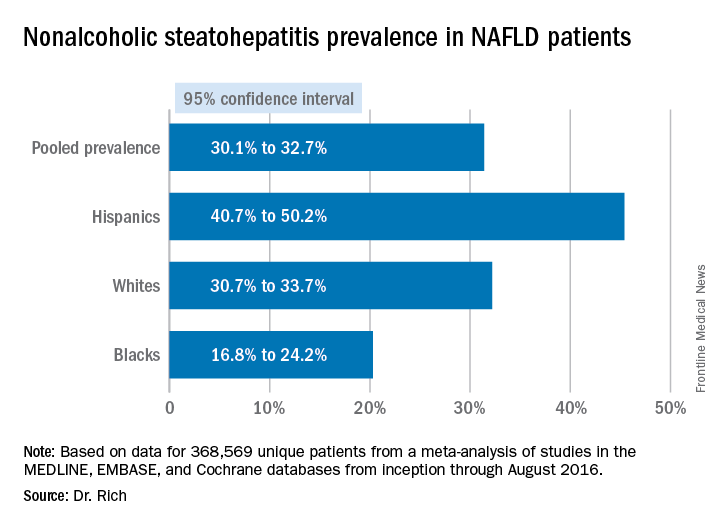WASHINGTON — Significant racial and ethnic disparities exist in nonalcoholic fatty liver disease prevalence and severity in the United States, with Hispanics at highest risk and blacks at the lowest, but the risk of death from NAFLD is highest in whites, according to a meta-analysis of 34 studies presented at the annual meeting of the American Association for the Study of Liver Diseases.
“When we calculated the pooled relative risk in Hispanic patients, compared to whites, we found the prevalence of NAFLD was higher in Hispanic patients with a relative risk of 1.47 in the population-based cohort, compared to 1.16 in the high-risk cohort,” said Nicole Rich, MD, of the University of Texas Southwestern Medical Center, Dallas. “When we looked at white patients compared to black patients, we found in the population-based cohort the proportion of white patients with NAFLD was 14.4%, compared to 13% in black patients.” In the high-risk cohort, the proportion of white patients with NAFLD was 55.5% vs. 47.6% in blacks. That prevalence translates into higher relative risks of NAFLD for whites vs. blacks, Dr. Rich noted: 1.35 in the population-based cohort and 1.28 in the population-based cohort.The findings are based on a meta-analysis of studies in the MEDLINE, EMBASE, and Cochrane databases from inception through August 2016 that included 368,569 unique patients that characterized disparities in NAFLD prevalence, severity, or prognosis, Dr. Rich said.
When the researchers drilled down into the data, they found the disparities dissipated somewhat. “When we looked at the severity of NAFLD we looked at two things: whether there was NASH (nonalcoholic steatohepatitis) present, or if there was the presence of advanced fibrosis,” Dr. Rich said. “We found there was no significant difference in the risk of NASH in Hispanic patients, compared to white patients; however, the proportion of Hispanic NAFLD patients that had NASH was 45.4%, compared to 32.2% in whites.” The pooled relative risk was 1.09.
The risk of advanced fibrosis in Hispanics was also not significantly different from the risk in whites, with a pooled relative risk of 1.02. “However,” Dr. Rich added, “we found that the risk of NASH was higher in white patients, compared to black patients.” The proportion of whites with NASH was 32.2% vs. 20.3% in blacks, with a pooled relative risk of 1.38, “with very little heterogeneity in those studies,” she said. The risk of advanced fibrosis, however, was similar between whites and blacks, with a pooled relative risk of 0.91 in whites vs. blacks.The meta-analysis tended to attenuate the disparities found in disease severity, compared with the disparities the researchers found in prevalence, Dr. Rich said. “Data are limited and discordant on racial and ethnic differences in NAFLD prognosis and outcomes,” she said. “In the current literature the studies have notable limitations, highlighting the need for future high-quality data in this area, and further studies are needed to determine the need and pathways to reduce NAFLD disparities in the future,” she said.
Dr. Rich had no financial relationships to disclose.



